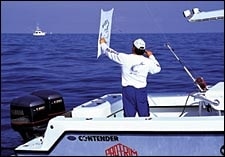
One of the best things about kite fishing is that you frequently get to see the strike. A recent trip off the Florida Keys serves as a good example. We had been fishing for several hours without any action, when the two pilchards that were dangling from our kite suddenly became terrified by something below and began swimming in circles on the surface.
Such behavior signals the presence of a predator, and sure enough, two sailfish appeared beneath the baits and engulfed the pilchards simultaneously. When the fish felt the hook they headed off in opposite directions, jumping frantically and shaking their heads. Such scenes make an offshore fisherman’s trip!
We might have caught the sails on free-lined baits, of course, but the kite made it much more exciting, and may have even helped entice the fish to eat in the first place. That’s because kites allow you to keep most or all of your terminal tackle out of the water, so fish see less of the hook, leader and knots. Instead, they focus on the thrashing baitfish.
While sailfish are the species most closely associated with kite fishing, they are by no means the only fish you can catch using this versatile technique. Tunas, dolphin, wahoo, king mackerel, cobia and even tarpon (yes, tarpon) can all be caught with the aid of kites at one time or another. Basically, any fish that likes live bait presented near the surface can be taken with a kite.
Setting Up a Kite Rig
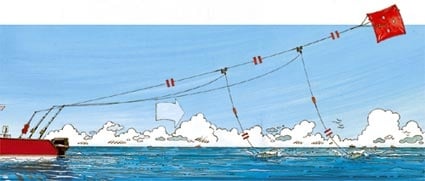
For those of you who are unfamiliar with kite fishing, let’s go over some basics. A specialized fishing kite is flown from the boat with several release clips attached at intervals along the kite line. The fishing lines are snapped into the clips as the kite is let out, thereby taking the baits the desired distance from the boat. The fishing line goes up to the clip, then straight down to the water. (A solid ring is sometimes placed on the fishing line to minimize abrasion and to keep the line from tangling in the clip.)
By paying close attention and adjusting the line, you can keep the bait on the surface, where it makes a commotion that predators often find irresistible. Furthermore, instead of lying in the water, where a fish might see it, your leader hangs in the air above the baitfish, out of sight.
Kite rods are stumpy versions of fishing rods with one or two guides, and the release clips are usually Black’s outrigger clips that have been pre-drilled with various size holes in them. Swivels are tied into the kite line, which is often made of Dacron because it cuts the wind better. A small swivel is placed nearest the kite, followed by a larger swivel.
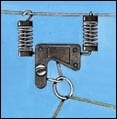
The DuBro release clip easily attaches to any part of the kite line and can be quickly removed for storage.| |

Black’s release clip with ¿ring.| |
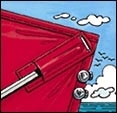
When two kites are used simultaneously, split-shot sinkers can be crimped to the outside corners to keep them from tangling.| The first release clip (the one closest to the boat) has a large enough hole to slide over the smaller swivel, so it can be reeled in with the line, while the second, larger swivel keeps it from sliding down the line when deployed. The release clip closest to the kite has a smaller hole and is held in place by the first swivel. If you don’t want to deal with swivels, a company called DuBro makes a release clip that simply snaps onto the kite line wherever you want to put it. Lots of captains are switching to this clip because it lets you alter the spacing of your baits to match the conditions, and you eliminate the use of swivels entirely. Conventional wisdom has the clips spaced about 60 feet apart. That’s open to individual interpretation, of course, but 60 feet seems to be close enough to keep the baits relatively near one another, yet far enough apart to keep them from tangling. Long leaders (ten feet plus) are the norm, and most people place a marker of some sort where the leader and double line meet so they can tell how deep the bait is. Fluorescent surveyor’s tape and small orange floats work well as markers, and be sure to use a quality ball-bearing snap swivel between the leader and double line, because the baits swim in circles lots of times, which can turn your line into a twisted mess in no time.
That’s a very general description of kite fishing, which is something of an art form. To learn more, we asked Captain Randy Towe of Tavernier, Florida (305-852-8501) to give us some tips on kite-fishing strategy. Randy is a Florida Keys guide who happens to be proficient at both flats and offshore fishing. He does the latter in his 31-foot Contender, Quit Yer Bitchin’, and he spends a lot of his time fishing with kites.
Fly It Quiet
Randy fishes kites while drifting, but also uses them at anchor if current and/or wind carry him out of his preferred depth range. “The ideal situation is drifting with the engines off, so everything’s quiet,” Randy says. “A good drift is 45 minutes to an hour where I can stay in the general water depth I want to be in. The current is the real key.”
For example, when sailfishing, you normally want to be just off the reef line in 80 to 200 feet of water. If the wind and current allow you to drift parallel to the reef, keeping you in the same relative depth, you’re in good shape. But when the wind blows hard perpendicular to the reef, you may end up too shallow or too deep, so anchoring in your chosen depth is the way to go.
In a normal spread, Randy fishes two lines off the kite and a couple of flat lines. Many captains use kites to take the baits far away from the boat, but Randy likes them closer. “I fish my kite baits close together, with the first swivel 25 feet from the kite and another 25 feet below that,” Randy explains. “This setup increases the number of double hook-ups, but it also means you have to pay very close attention to the baits to keep them from tangling.”
Randy also doesn’t hesitate to put out a second kite up if the first kite is out-producing the flat lines. He keeps the kites separated by crimping a large split-shot to the outside corners of the two kites. The weight makes the kites fly off to one side, away from each other. You can also run the kite lines though your outrigger pins and out to the end of the ‘riggers to separate the kites even more.
Favorite kite baits in South Florida include goggle-eyes, blue runners, pilchards, and cigar minnows. “The main thing about bait presentation is to make them look natural,” Randy says. “The better a bait looks to you, the better it looks to a fish.”
Many Florida kite fishermen attach their baits to the hooks via bridles, but Towe likes to hook them lightly through the back. “Hooking baits in the back has brought us just as much success as bridling, and it’s much faster,” he explains. “If you could prove to me that bridling keeps the baits from spinning and will improve my hook-up ratio, then I’d be all for it, but the bridling process really is just too time consuming.”
Dropback Debate
Dropping back is another important consideration in kite fishing. Some anglers prefer letting a fish run with the bait while the line remains in the kite clip (also referred to as a “pin”), while others like to snap the line from the clip and drop back to the fish straight from the fishing rod. “The dropback is a Catch-22, but you really can’t go wrong if you let them eat it a while with the line in the pin,” Randy says. “If I see a fish come up on the bait, I like to drop it back via the clip. Once the fish has taken the bait it will accelerate. That’s when you can lock up and come tight on them.”
Towe adds that many people don’t fish kites because they feel it’s too much trouble. One sure way to make it easier on yourself is to spring for an electric kite reel. “Once you’ve seen how easy electric reels make it, you’ll never wind in another kite by hand,” Randy exclaims. “It’s an apples-to-oranges difference.”
By experimenting with kites you can add a new dimension to your fishing arsenal. Kites can produce on slow days when conventional techniques fail, but perhaps equally important is the excitement factor. Very little in offshore fishing is as exciting as watching a fish crash or skyrocket on a frantic baitfish fluttering on the surface. It’s what live-bait fishing is all about, and kites take it to another level. Try it for yourself and see why captains like Randy Towe never leave the dock without a kite aboard.
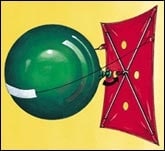
When winds are less than 4 mph, a large helium balloon (three-foot diameter) can be attached to the kite to get it airborne. Once the balloon is inflated and knotted, it can be secured to the backside of the kite with a piece of cotton or Dacron line taped across the center of the balloon and tied to the edges of the kite. If using an AFTCO kite, tie the ends of the line to the kite’s special nylon loops (balloon line should be tied loosely to kite to keep from deforming the kite’s sail). To finish, fasten the balloon’s nipple to the kite’s center clip.|
¿









